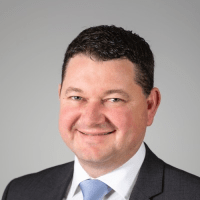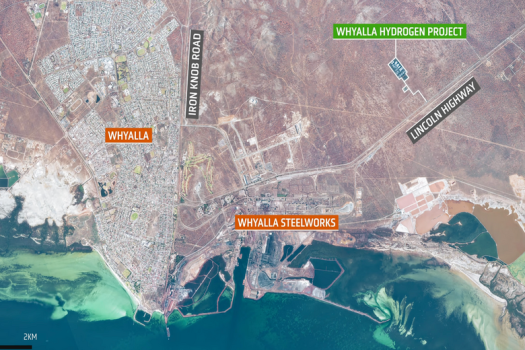South Australia is well placed to lead the energy transition with a major program of work to position it as a green iron and steel powerhouse, a renewable energy conference heard.

The CEO of SA’s Office of Hydrogen Power Sam Crafter provided an overview of the state’s vision of its place in a post-carbon world at the Smart Energy Conference in Sydney last week.
The office was established as part of the Department for Energy and Mining in 2022, tasked with overseeing the delivery of the state’s Hydrogen Jobs Plan, the Port Bonython Hydrogen Hub and industry engagement to accelerate the state’s emerging hydrogen economy.
At present its attention is on building a grid-scale hydrogen power plant in the Whyalla steel making region and establishing the state’s first large-scale clean hydrogen precinct for export and domestic markets.
Renewable energy targets brought forward
Premier Peter Malinauskas last month announced the state is bringing forward its renewable energy target by three years with a goal to source energy from 100 per cent renewables by 2027.
“We think South Australia is well positioned to lead the transition in our energy usage and production … to more than 74 per cent renewables this year, and on track to 100 per cent by 2030,” Mr Crafter told the conference.
He said South Australia has what the world needs – abundant solar and wind resources, mineral riches including copper and iron ore, and steel manufacturing infrastructure and capability.
“That provides a platform for the opportunities we’ve been talking about today,” he said during a panel discussion titled The Hydrogen Race.
When you think about the opportunities for decarbonisation we are absolutely convinced that SA is very well positioned to capitalise on existing industry.
Sam Crafter
Mr Crafter said SA currently provides 69 per cent of Australia’s copper, a crucial element for renewable energy technologies, and has more than 6 billion tonnes of magnetite iron ore, which lends itself to green production techniques.
“The other thing we have is two steelworks, all within this proximity,” he said.
“So when you think about the opportunities for decarbonisation we are absolutely convinced that SA is very well positioned to capitalise on existing industry … and to deliver in a quick time frame, to be a leader as we have been in other elements of the energy transition.”
Massive water infrastructure project
The state government is also undertaking a major water infrastructure program to support a range of sectors including the planned hydrogen industry.
The Northern Water project will see the construction of a seawater desalination plant with water drawn from the Spencer Gulf and distributed via a 600km pipeline linking the Eastern Eyre Peninsula, Whyalla, Port Augusta, Woomera, Carapateena, Roxby Downs, Pimba, and Olympic Dam.
A Final Investment Decision on the project is expected in the first half of 2026.
The march to green iron
The other opportunity South Australia is focusing on, Mr Crafter said, is green iron, made with hydrogen produced by renewable energy.
He said steel production using fossil fuels currently produces 2 tonnes of Co2 for every tonne of steel produced, and accounts for up to nine per cent of global emissions.
Work to get a hydrogen industry up and running in the state has been underway since 2017, with the release its Hydrogen Roadmap.
“Consecutive governments have taken up the opportunity which is very helpful for us in the public service, so we have a whole range of work ,” Mr Crafter said.
“That includes an export modelling tool, an action plan, and a study done with the Port of Rotterdam (in The Netherlands) into transporting derivative products from South Australia to Europe, which shows it can be done economically.”
Hydrogen plant in the Upper Spencer
The state government has selected partners ATCO Australia, BOC, EPIC Energy and GE Vernova to deliver its Hydrogen Jobs Plan, centred around what it says will be the world’s biggest hydrogen production facility, power plant and storage at Whyalla in the Upper Spencer Gulf.
The planned works include a 250 MW production facility, a 200 MW hydrogen power plant and 3,600 tonnes of storage.
Mr Crafter told the conference construction is set to begin in the second half of this year, with operations to get underway in 2026.

A single regulatory framework
South Australia also last year legislated the Hydrogen and Renewable Energy Act which is designed to support the delivery of the Hydrogen Jobs Plan and establishment of what the government hopes will be a world-leading green hydrogen sector.
The Act , which passed the South Australian parliament last November, will streamline the process for companies wanting to invest in large-scale hydrogen and renewable energy projects in the state via a single regulatory framework.
“For us, the message about what South Australia is onto is simple,” Mr Crafter said.
“The world needs copper to make the (renewable energy) transition, copper needs water, the world needs green steel, green steel needs hydrogen. We’re building hydrogen production in south Australia, and from that we’ll have industry coming behind us.”
Read more: The case for a carbon levy on fossil fuel producers.





I would seem South Australia is always the leader in legislated work to develop and build systems to reduce the effects of climate change and should be congratulated.
Could the planned 200 megawatt power plant be a small nuclear reactor? Characters like Weatherill & Scarce have been putting a lot of effort into spruiking nuclear in other forums. Never mind that the leading SMR proponent in the US, NuScale, has abandoned its Utah project. Lack of economic feasibility doesn’t worry punters who expect a leg up from the public purse.